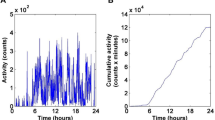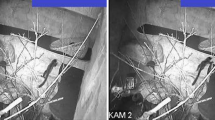Abstract
A group of four wolves 1–7 months old was observed. The wolves were kept in 1.5 hectare forest aviaries. Twenty-four-hour observation was performed once every 7–10 days in summer time and once every 15–20 days in autumn. Using the time slice method, the activity type of each animal was registered each minute. Eighteen types of activity were recorded. The sequential stream of activity of all four animals was analyzed to find time patterns that are repetitive events not randomly following each other within the critical time interval. A lot of types of time patterns including different activities were observed (1300–13 500 types). There are patterns of individual, social, and mixed activities. A dramatic increase followed by s decrease in the number of pattern types was registered in the period from the 75th to the 115th days. Other important changes in ontogenesis of growing wolf cubs are related to this period.
Similar content being viewed by others
References
Badridze, Ya.K., Volk. Voprosy ontogeneza povedeniya, problemy i metody reintroduktsii (Wolf: Ontogenetic Behavior Issues and Problems and Methods of Reintroduction), Tbilisi: Tbilis. Gos. Univ., 2003.
Blidchenko, E.Yu. and Bologov, V.V., Tendencies in Changes in Weight Depending on Social Status during Growth of Young Wolfs (Canis lupus), in Mater. Nauch. Konf. “Povedenie i povedencheskaya ekologiya mlekopitayushchikh” (Proc. Sci. Conf. “Behavior and Behavioral Ecology of Mammals), Chernogolovka, 2009, p. 118.
Bramblett, C.A., Social Organisation as an Expression of Role Behaviour among Old World Monkeys, Primates, 1973, no. 14, pp. 101–112.
Ernandes-Blanko, Kh.A., Poyarkov, A.D., and Krutova, V.I., Organization of a Family Group of Wolfs (Canis lupus lupus) in the Voronezh Biosphere Reserve, Zool. Zh., 2005, vol. 84, no. 1, pp. 80–93.
Filatova, O.A., Kruchenkova, E.P., and Gol’tsman, M.E., Stereotype Sequences in the Calling Signal of the Arcic Fox (Alopex lagopus Semenovi) from the Mednyi Island, Zool. Zh., 2009, vol. 88, no. 3, pp. 357–364.
Fox, M.W., Behaviour of Wolves, Dogs and Related Canids, London: J. Cape, 1971.
Gartlan, J.S., Structure and Function in Primate Societies, Folia Primatol., 1968, vol. 8, pp. 89–120.
Gol’tsman, M.E., Social Domination and Behavioral Roles in Great Gebrils in Gruppovoe povedenie zhivotnykh (Group Behavior of Animals), Moscow: Nauka, 1976, pp. 72–75.
Haind, R., Povedenie zhivotnykh (Animal Behavior), Moscow: Mir, 1975.
Joslin, P.W., Movements and Home Sites of Timber Wolves in Algonquin Park, Am. Zool., 1967, vol. 7, pp. 279–288.
Locwood, R., Dominance in Wolves: Useful Construct or Bad Habit?, in The Behavior and Ecology of Wolves, Kling-hammer, E., Ed., New York: Garland STPM Press, 1979, pp. 225–244.
Magnusson, M.S., Discovering Hidden Time Patterns in Behavior: T-Patterns and Their Detection, Behav. Res. Methods Instrum. Comput., 2000, vol. 32, no. 1, pp. 93–110.
Magnusson, M.S., Hidden Real-Time Patterns in Intra- and Inter-Individual Behavior, Eur. J. Psychol. Ass., 1996, vol. 12, no. 2, pp. 112–123.
Mech, D.L. and Boitani, L., Wolves. Behavior, Ecology, and Conservation, Mech, D. and Boitani, L., Eds., Chicago: Univ. Chic. Press, 2003, pp. 1–35.
Mech, D.L., The Wolf: The Ecology and Behaviour of an Endangered Species, New York: Nat. Hist. Press, 1970, p. 396.
Mech, D.L., Alpha Status, Dominance, and Division of Labor in Wolf Pack, Can. J. Zool., 1999, vol. 77, pp. 1196–1203.
Moran, G. and Fentress, J.C., A sEarch for Order in Wolf Social Behavior, in The Behavior and Ecology of Wolves, Klinghammer, E., Ed., New York: Garland STPM Press, 1979, pp. 245–283.
Murie, A., The Wolves of Mount McKinley, US Nat. Park. Serv. Fauna, 1944.
Nikol’skii, A.A. and Frommol’t, K.N., Vokal’naya aktivnost’ volka (Vocalization Activity of Wolf), Moscow: Mosk. Gos. Univ., 1989.
Olson, S.F., Organization and Range of Pack, Ecology, 1938, vol. 19, pp. 168–170.
Panov, E.N., Mekhanizmy kommunikatsii u ptits (Communication Mechanisms in Birds), Moscow: Nauka, 1978.
Peters, R., Mental Maps in Wolf Territoriality, in The Behavior and Ecology of Wolves, Klinghammer, E., Ed., New York: Garland STPM Press, 1979, pp. 119–152.
Popov, S.V. and Il’chenko, O.G., Rukovodstvo po issledovaniyam v zooparkakh. Metodicheskie rekomendatsii po etologicheskim nablyudeniyam za mlekopitayushchimi v zooparkakh (Guidelines to Studies in Zoos: Guidance to Etological Observations of Mammals in Zoos), Moscow: Moskovskii zoopark, 2008.
Poyarkov, A.D., Historical (Biographic) Method of Description of Social Organization and Behavior of Stray Dogs, in Metody issledovaniya v ekologii i etologii (Methods of Studies in ecology and Ethology), Pushchino: ONTI NTsBI AN SSSR, 1986, pp. 172–203.
Sabaneev, L.P., Wof, Priroda (Moscow, Russ. Fed.), 1877, no. 2.
Schassburger, R.M., Wolf Vocalizations: an Integrated Model of Structure, Motivation and Ontogeny, in Man and Wolf: Advances, Issues and Problems in Captive Wolf Research, Frank, H., Ed., Netherlands; Dordrecht: Dr. W. Junk Publ., 1987, pp. 313–347.
Schenkel, R., Expression Studies of Wolves, Behavior, 1947, vol. 1, pp. 81–129.
Yachmennikova, A.A., Pyatkova, A.A., Zaraiskaya, I.Yu., and Poyarkov, A.D., Complex Patterns of Organization of Wolf (Canis lupus) Activity in Social Group, in Mater. Nauch. Konf. “Povedenie i povedencheskaya ekologiya mlekopitayushchikh” (Proc. Sci. Conf. on Behavior and Behavioral Ecology of Mammals), Chernogolovka, 2009, p. 18.
Young, S.P. and Goldman, E.A., The Wolves of North America, Washington, DC: DC: Amer. Wildlife Inst., 1944.
Yudin, V.G., Volk Dal’nego vostoka Rossii (Wolf in the Far East of Russia), Blagoveshchensk: Izd. DVO RAN, 1992.
Author information
Authors and Affiliations
Corresponding author
Additional information
Original Russian Text © A.A. Yachmennikova, A.D. Poyarkov, 2011, published in Izvestiya Akademii Nauk, Seriya Biologicheskaya, 2011, No. 2, pp. 198–207.
Rights and permissions
About this article
Cite this article
Yachmennikova, A.A., Poyarkov, A.D. A new approach to study organization of wolves’ activity (Canis lupus) in time sequences. Biol Bull Russ Acad Sci 38, 156–164 (2011). https://doi.org/10.1134/S1062359011020154
Received:
Published:
Issue Date:
DOI: https://doi.org/10.1134/S1062359011020154




